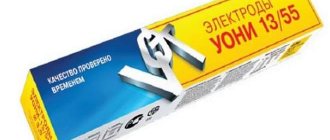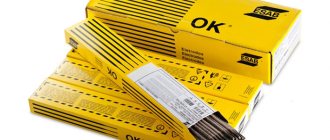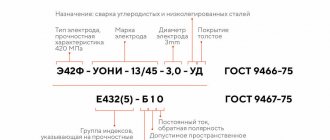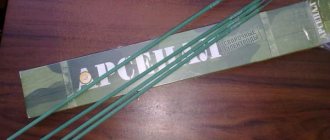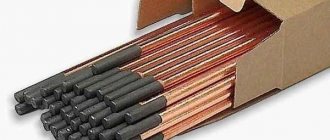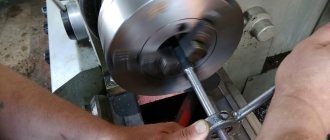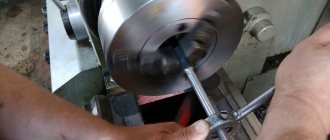Classification
According to GOST 9466-75, coated metal electrodes for manual arc welding are divided according to their intended purpose:
- and carbon steels of structural type - U. Temporary tensile strength does not exceed 60 kgf/mmI.
- of structural alloy steel – L. Tensile strength over 600 MPa.
- Impact on heat-resistant steels supplemented with alloy elements - T.
- Welding of high-alloy steels with special properties - B.
- Surfacing of surface coatings with modified properties - N.
Weld metal or surfacing
Surfacing is a welding operation in which a layer of molten metal (called filler material) is applied to the internal or external surface of a part. Surfacing is performed for the purpose of:
- restore the original dimensions of the worn part;
- bring the dimensions to the design ones when manufacturing a part and detecting a removable defect;
- create a coating of one metal with a layer of another in order to increase corrosion resistance or impart special physical or chemical properties;
- strengthen the surface layer.
Surfacing
The electrode is guided along the surface of the part at a given location. The top layer of metal of the part melts and, together with the metal of the electrode, forms a surfacing layer. If necessary, several layers are deposited. Despite the fact that there are special surfacing electrodes, E42 can also be used for surfacing relatively small volumes of metal.
Dimensions
Electrodes are manufactured according to nominal diametrical dimensions . When ordering in bulk, some manufacturers can produce products with custom sizes. Sometimes the coating on the edge is not cleared, but both ends must remain in contact. In the total batch, no more than 10% of electrodes have a length deviation of 4 mm.
The electrode is made of several structural elements: 1 – rod; 2 – transition zone; 3 – coating; 4 – contact end.
The cleaning area has a conical, round or combined shape. The inclination of the cone is not regulated in any way, since it does not affect operation.
Ionizing elements are applied to the contacts, which facilitates the appearance of the welding arc. Product marking: electrodes E46 GOST 9466-75 with a diameter of 4 mm.
Successful analogues for replacement
E42 electrodes are widespread and are produced by all major manufacturers. Therefore, the need to look for an alternative rarely arises. If it does exist, use consumables similar in composition from Esab (Sweden).
The choice of model depends on which brand of E42 electrode requires replacement:
- ANO-6 - Esab OK 46.00.
- OZS-23 and OMA-2 - OK 43.32.
- WCC-4 - OK Pipeweld 6010. This consumable is no longer produced; the remaining stock in warehouses is being sold.
Manufacturers are developing new types of electrodes.
Manufacturers are constantly developing new types of electrodes, so it is possible that new analogues of E42 will appear in the future. They should be selected according to the chemical composition and coating material. For most E42 it is rutile, and the rods are made from welding wire Sv-08 or Sv08A according to GOST 2246-70.
Technical requirements
Metal consumable electrodes are manufactured in accordance with GOST 9466-75, but with modifications. The main element is made of special wire . The coating is durable, without pores, swelling, or cracks. The presence of minor irregularities is normal; deep dents and lingering scuffs are considered defective. The length of the damage does not exceed 3 times the diametrical size. The normal depth of dents is up to 50% of the total thickness of the coatings; there can be up to 4 of them with a total length of maximum 25 mm on the product.
Calcination (drying)
If the electrodes were not stored in a sealed package and could become damp, then it is recommended to calcinate them. It should be noted that calcining the electrodes immediately before use is a critical procedure that ensures the ignition of the arc.
At the same time, experts do not recommend getting too carried away with it, since excessive and frequent heating of the rod can lead to damage to the special coating.
It is advisable to accurately calculate the required number of products and dry them in such a way that upon completion of the work there are none left at all or only a minimum remains.
The next time you turn to welding operations, the previously dried electrodes should be worked out first.
Calcination is also necessary in order to slightly raise the temperature of the consumable immediately before using it for welding pipes, for example. Few product samples are able to immediately provide the required operating conditions due to too large a temperature difference in the welding zone.
Additional heating of the rods also ensures the tightness of the connection formed during the so-called “pressure welding”. However, this requires gradual heating to allow the accumulated moisture to evaporate to avoid the appearance of limescale.
The issue of calcination is closely related to the maximum time and storage conditions. According to current regulations, the shelf life of these products is approximately five years. But, according to a number of experts, they can be used for some time after the warranty period expires.
Acceptance rules
Acceptance testing in accordance with the requirements of the current standard is mandatory. The inspector analyzes the condition of the electrodes for compliance with technical specifications, checks the appearance and the absence of moisture in the packaging.
All products from a batch are manufactured according to a single technical process, on identical machines, using the same brand of wire.
From 1 ton of batch, 0.5% of electrodes are selected from various packing places. If the study shows an unsatisfactory result, then it is repeated, but with a double number of products. The result of the second analysis is final and applies to the entire batch. In the event of a defect, you must act immediately by contacting the supplier.
The presence of moisture, deviations in the size and number of pores are eliminated by calcination, followed by diagnostics for compliance with welding and technological qualities.
Coverage options
The working qualities of the electrode and the features of its use are largely determined by the material of the flux coating. There are several options:
- Sour. Based on silicon and iron oxides, manganese oxide is used as an additive. A connection made using such a coating is prone to the formation of hot microcracks.
- Rutile. Based on titanium dioxide. Compared to the previous option, the likelihood of the formation of hot microcracks is significantly reduced. Allows you to obtain a more stable and powerful electric arc. Reduces melt spattering and associated metal losses. Improves the formation and uniformity of the seam, forms an easily removable slag crust, which reduces the labor intensity of subsequent cleaning operations.
- Basics. It is based on bases - fluorine compounds mixed with carbonates. According to the degree of deoxidation, it corresponds to calm type steels. The suture material acquires high ductility and impact strength, both at room and at low temperatures. The likelihood of hot microcracks appearing is also reduced.
Electrodes "Tien Shan" type E42
For any type of coating, the requirement for use only in dry form remains. If you try to use wet electrodes, manufacturers disclaim their warranty on the quality of the seam. The products are supplied in hermetically sealed boxes with cellophane; they should be printed immediately before starting work. If the electrodes do become wet, they must be dried and calcined in a muffle furnace.
Also, regardless of the coating option, it is necessary to carefully follow the technology and welding modes.
Test methods
Linear dimensions are examined with an error of 1 mm. The depth of the dents and the length of the exposed part of the rod are measured with an error of 10 times less, that is, with 0.1 mm. To determine the thickness, measurements are carried out on three sections of the product, between which a distance of 5-10 cm is maintained. To measure this value, a micrometer is used, as well as high-precision magnetic devices.
Welding and technological indicators are checked by creating branded products . On double-sided products, the likelihood of cracks in the seam is checked. The quality of the weld is checked for cracks using a 5x magnifying glass.
Analogues, what to replace
E42 is interchangeable with a large number of analogues . They can be replaced with electrodes of the E42A type (with an acid coating; pores do not form during welding if the metal has traces of scale. It must be borne in mind that such seams are prone to hot cracks).
Replacement of type E42 of Russian brands with analogues from ESAB (Sweden)
E42 | analogues ESAB (Sweden) |
| ANO-6 | OK 46.00 |
| OZS-23 | OK 43.32 |
| OMA-2 | OK 43.32 |
| WCC-4 | OK Pipeweld 6010 (discontinued) |
The main criterion for the replaceability of electrodes will be the material of the welding wire from which the products are made. This material must have a composition approaching that of the alloy that is formed when an alloy or pair of alloys are welded. The chemical composition of the weld alloys formed during welding determines its mechanical and corrosion properties. For E42, welding wire grades Sv-08, Sv-08A are used according to GOST 2246-70. Of the coatings, rutile (a mineral with a high content of titanium dioxide) is most often present.
See also the table of replaceability of Russian electrodes with imported ones for low-carbon and low-alloy steels.
For your information! E42 electrodes are widespread, there are many manufacturers, and the price of this material is relatively low. Therefore, the search for analogues for this material is quite rare.
Quality certification
In Russia, there is currently no mandatory certification required for general-purpose welding electrodes . However, the consumer may request such a document from the manufacturer.
Certificates of the Maritime and River Registers are required for welding materials that are used in the relevant conditions. A Rostechnadzor certificate is required for materials used in hazardous industries.
Most enterprises voluntarily certify their products in order to expand the sales market. Most E42 type products are produced with certificates.
The presence of certificates allows you to control manufacturers and suppliers for quality. Welded joints, as a rule, carry a large mechanical load and therefore all work associated with welding is ultimately expensive. Therefore, all consumers should be interested in high quality welding electrodes.
Popular manufacturers
From Russian enterprises: SpetsElektrod (Moscow), LEZ, SZSM, Ural Electrode Plant LLC. Imported: ESAB (Sweden), Lincoln Electric (USA), Kobleco (Japan).
Designation
In Russia, electrodes are designated according to GOSTs 9466-75 and 9467-75 (current). On the “Marking of welding electrodes” page, see what the markings mean and the interpretation of individual fields.
All details of the characteristics (there are quite a lot of them) are in the specified GOSTs.
Keep in mind! Marking must be present on the packaging or wrapper; in some cases, enterprises even mark the electrodes themselves by applying markings to the coating.
For what steels
Electrodes of type E42 can be used to weld carbon and low-alloy steels for most light-duty metal structures. They cannot be used when welding vertical seams from top to bottom. The current source can be either alternating or constant. In case of direct current, reverse polarity must be used. Slag is easily removed from any seams.
Type E42, especially ANO-6, is often used for home welding work. The arc from them burns stably, ignites without much difficulty and is easy to hold for non-professional welders.
Can any electrodes of this type be used on stainless steel?
Need to know! For type E42 there are no grades suitable for welding stainless steels.
Stainless steels, for weld uniformity, must be welded with stainless steel wire containing chromium and nickel in appropriate proportions. If you weld stainless steel with E42 type electrodes, then the seam will, at a minimum, be subject to severe corrosion and the entire value of stainless steel in such a design will be meaningless. The mechanical properties of the seam will also be low. See here about stainless steel electrodes.
All brands of electrodes
Packaging, labeling, transportation and storage
To determine the varieties and characteristics, the labeling should be analyzed. The packaging contains information about 9 main indicators of welding electrodes according to GOST:
- Type . The designation begins with the value “E”, which indicates the electrode, followed by numbers that show the permissible tensile force, followed by the index A, which describes the resistance of the seam to impact stresses.
- Brand . The parameter is regulated by the policy of the manufacturer.
- Diameter _ The thickness of the internal zone of the electrode is in the range of 1.6 – 12 mm. For domestic use, devices with a thickness of no more than 5 millimeters are used. Electrodes with a diameter of no more than 2 mm are common in enterprises involved in the production of small-sized devices.
- Purpose . According to this parameter, products are designated by letter values - U, L, T, V, N.
- Thickness _ The parameter is characterized by the ratio of the inner part of the rod to the size of the coating.
- Seam properties . The characteristic indicates the percentage of chemical elements of the alloy and the operating temperature of the weld. Detailed decoding can be seen in special tables.
- Type of welding current and connection method.
- A type of electronic coating.
- Location markings.
There are several types of electrodes. Correct decoding of the marking allows you to choose the most appropriate product for a specific task. Products are packaged in packs or boxes:
- sealed plastic cases;
- packages in wrapping paper placed in metal containers;
- boxes with a minimum cardboard thickness of 0.7 mm, wrapped in polyethylene;
- cardboard boxes with a thickness of more than 0.8 mm;
- packs with a sealed shell and wrapping paper;
- packaging made from two-layer special paper or a moisture-resistant analogue.
Deputy General Director of NPO Spetselektrod LLC Bystrov V.I.: “Transportation and storage conditions have a huge impact on the quality of electrodes. Therefore, several complete checks are carried out before dispatch. The boxes are placed in medium-sized containers, the loading must be carried out to the fullest extent, and shelves are installed between the tiers. Each tier cannot exceed 60 cm in height.”
Each batch is supported by a quality certificate. Electrodes are stored in rooms with minimal humidity and temperatures above 15 degrees.
Features of operation
E42 electrodes are easy to use, easy to ignite and withstand voltage surges well. Most types weld rusty and damp metal without losing the strength and ductility of the joint.
The slag crust on the weld surface is easily separated, which reduces the cost and speeds up finishing.
Welding modes
This concept denotes actions and parameters designed to ensure high quality welds under given conditions.
Welding modes provide high quality seams.
Indicators are divided into 2 groups:
- basic;
- additional.
The first include:
- type and strength of current;
- electrode diameter;
- arc voltage.
Additional:
- spatial position of the seam;
- speed of movement of the consumable;
- composition and thickness of the metal.
E42 electrodes are used to cook with direct and alternating current, in the first case with reverse polarity. The amperage is related to the diameter of the consumable and the thickness of the workpieces being connected.
The data is summarized in the table:
We recommend reading Description of rutile-coated electrodes
| Thickness of welded parts, mm | 0,5 | 1-2 | 3 | 4-5 | 6-8 | 9-12 | 13-15 | 16 |
| Electrode diameter, mm | 1 | 1,5-2 | 3 | 3-4 | 4 | 4-5 | 5 | 6-8 |
| Current strength, A | 10-20 | 30-45 | 65-100 | 100-160 | 120-200 | 150-200 | 160-250 | 200-350 |
Wrong choice of electrode leads to the fact that the diameter becomes:
- Reduced. The coating is damaged and the arc loses stability.
- Enlarged. The current density drops and the arc is drawn across the surface of the workpiece. Because It is difficult to maintain a constant length, the seam becomes crooked and loses strength.
The welding mode is selected taking into account the capabilities of the inverter, i.e. maximum amperage for this model. Vertical and ceiling seams are welded with a consumable with a diameter of 4 millimeters, regardless of the thickness of the parts being connected.
The welding mode is selected taking into account the capabilities of the inverter.
The speed of the process affects the width of the seam. When moving quickly, it narrows, and vice versa. It is necessary to maintain the optimal speed, determined empirically.
Otherwise, the following consequences are observed:
- Acceleration. The material does not have time to warm up and melt, the joint turns out to be poorly welded.
- Slowdown. The metal flows out, the cross-section of the surfacing and, as a result, its strength decreases.
The optimal arc length is 3-4 mm. Stretching has a negative effect:
- During the journey from the electrode to the workpiece, the metal has time to oxidize.
- The arc is drawn across the surface, the heat is distributed over a larger area, and the material warms up worse. Melted drops freeze on it, clogging the seam.
The width of the joint and the penetration depth depend on the trajectory of the consumable. In addition to linear movement, zigzag and herringbone are used.
Existing restrictions
E42 consumables are not suitable for the following conditions:
- Perform vertical seams from top to bottom. Metal from the weld pool flows onto the untreated area.
- Connections of workpieces made of medium and high alloy steel, cast iron, non-ferrous metals.
- Welding with direct current of straight polarity (electrode-negative).
Consumables E42 are not suitable for vertical seams.
In the latter case, the cathode is the consumable. Compared to the anode, its temperature is higher (for melting products).
The parts being connected heat up worse, the penetration depth decreases; the coating on the electrode burns out too quickly and does not provide the required protection to the joint.
Is it possible to work with stainless steel?
Such materials are welded with electrodes containing nickel and chromium. E42 does not belong to this category, therefore it is not suitable for working with stainless steels.
Electrode storage
The coating of consumables, due to its porous structure, is hygroscopic, i.e. has a tendency to absorb moisture. Damp coating crumbles and burns poorly, as a result of which the seam does not receive protection from atmospheric oxygen and becomes weak and brittle.
Therefore, the following requirements are put forward for the storage location of electrodes:
- Relative humidity – less than 50%.
- The readings on the thermometer are not lower than +15°C. This means that during the cold season, consumables should be in a heated room.
- No temperature changes.
- Protection from direct sunlight.
If the packaging is opened, it is recommended to place the consumables in a special sealed case.
Points 2 and 3 are designed to prevent moisture condensation on products.
The specified conditions are also met if the electrodes are in sealed original packaging. With high humidity, they can become damp over time.
If the packaging is opened, it is recommended to transfer the consumables into a special sealed case with insulated walls. You can make it yourself from a plastic pipe of medium or large diameter.
We recommend reading Characteristics and operation of non-consumable electrodes
Before use, the products are calcined, i.e. heated to dry the coating. The procedure time and temperature are indicated on the packaging; you must strictly adhere to them. Overheating is especially dangerous for consumables with organic substances in the coating.
Dried electrodes are suitable for use for 8 hours. If they have not been used during this time, the calcination can be repeated. But the number of procedures is limited and for different models it is 2-4. Subsequent heating will cause the coating to peel off.
Certificate of Quality
The legislation of the Russian Federation requires that this document be obtained only for electrodes intended for work:
- In the navy. Certificates are issued by river and sea registers.
- In hazardous industries. The papers are issued by Rostechnadzor.
Manufacturers are not required to certify general purpose electrodes. But many do this on their own initiative in order to convince the buyer of the high quality of their products. Before purchasing consumables, it is recommended to ask the seller whether they have a certificate. Its presence will serve as a solid argument in favor of purchasing this brand.
Certificate for electrodes.
Application area
Electrodes of type E42 of all brands are widely used in the installation of industrial metal structures . The reason is that in industry and construction, in practice, work occurs with steels containing a small amount of carbon in their chemical composition. And this is a condition for the use of products of this type according to GOST.
E42 can be used for welding thin gas and water pipes, provided they are operated at relatively low pressure.
These products can be used by both professionals and novice welders. They can be used in private workshops and garages if there is a welding transformer.
The advantages of these rods include their availability on the market, since the cost is quite reasonable, about 70 rubles per kilogram.
- Granite.
- Paton.
- Vistek.
- Plasmatic.
- MaxWeld.
- Frenze-Electrode.
E42 electrodes reliably ensure constant operation of the arc, uniform melting of the metal and its continuous transfer into the weld pool. As well as good weld formation, slight spattering of metal, easy removal of slag from the surface of the seam and minimal toxicity of gases generated during the welding process.

